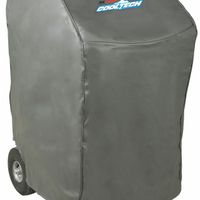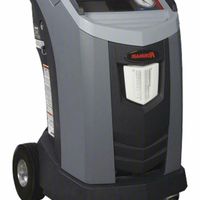Call +(254) 703 030 000 / 751 483 999 / 721 704 777
- Home
- Fleet Vehicle Maintenance
- Vehicle Tools
- Vehicle Heating Cooling Tools
- Ac Refrigerant Machines Accessories
AC Refrigerant Machines & Accessories
AC refrigerant machines and accessories support the maintenance and repair of vehicle air conditioning systems and enhance their performance. Read Less
Frequently Asked Questions
What type of refrigerant is used in my vehicle's AC system?
The type of refrigerant used in a vehicle's AC system typically depends on the vehicle's make, model, and year of manufacture. Here are the most common types:
1. **R-12 (Dichlorodifluoromethane)**: Used in vehicles manufactured before 1994. It is a chlorofluorocarbon (CFC) and was phased out due to its ozone-depleting properties.
2. **R-134a (Tetrafluoroethane)**: Became the standard refrigerant for vehicles manufactured from 1994 to the mid-2010s. It is a hydrofluorocarbon (HFC) and does not deplete the ozone layer but has a high global warming potential (GWP).
3. **R-1234yf (Tetrafluoropropene)**: Introduced as a more environmentally friendly alternative, it is used in many vehicles manufactured from the mid-2010s onward. It is a hydrofluoroolefin (HFO) with a much lower GWP compared to R-134a.
4. **R-744 (Carbon Dioxide, CO2)**: Used in some modern vehicles, especially in Europe. It is a natural refrigerant with a very low GWP and no ozone depletion potential.
To determine the specific refrigerant used in your vehicle, check the vehicle's owner manual or the under-hood sticker, which typically provides this information. If unavailable, consult a professional mechanic or the vehicle manufacturer.
How do I recharge my car's AC system with refrigerant?
1. **Safety First**: Wear safety goggles and gloves. Ensure the car is off and parked in a well-ventilated area.
2. **Locate the Low-Pressure Port**: Open the hood and find the low-pressure service port on the AC system. It’s usually on the larger diameter aluminum tubing between the compressor and evaporator.
3. **Check the System**: Use an AC gauge to check the current pressure. Ensure the system is low on refrigerant but not empty, as an empty system may indicate a leak.
4. **Attach the Refrigerant Can**: Connect the refrigerant can to the recharge hose. Shake the can well.
5. **Connect the Hose**: Attach the other end of the hose to the low-pressure port. Ensure it clicks into place securely.
6. **Start the Engine**: Turn on the car and set the AC to the highest setting. This helps circulate the refrigerant.
7. **Add Refrigerant**: Open the valve on the can to release refrigerant into the system. Hold the can upright and gently shake it as it dispenses. Monitor the pressure gauge to avoid overcharging.
8. **Monitor the Pressure**: Keep an eye on the gauge. The ideal pressure range is usually between 25-45 psi, but check your vehicle’s specifications.
9. **Close the Valve**: Once the desired pressure is reached, close the valve on the can and remove the hose from the low-pressure port.
10. **Check AC Performance**: Test the AC to ensure it’s cooling effectively. If not, further diagnosis may be needed.
11. **Dispose of the Can**: Follow local regulations for disposing of the empty refrigerant can.
12. **Check for Leaks**: If the AC performance doesn’t improve or refrigerant levels drop quickly, inspect for leaks and repair as necessary.
What are the signs of a refrigerant leak in my vehicle's AC system?
1. **Reduced Cooling Efficiency**: The AC system may not cool the cabin as effectively, taking longer to reach the desired temperature or failing to cool at all.
2. **Hissing or Bubbling Sounds**: Unusual noises, such as hissing or bubbling, may be heard when the AC is running, indicating a possible leak in the system.
3. **Visible Refrigerant Leaks**: Oily residue or visible liquid spots under the vehicle or around AC components can indicate a refrigerant leak.
4. **AC Clutch Not Engaging**: The AC compressor clutch may fail to engage due to low refrigerant levels, preventing the system from cooling.
5. **Frequent Cycling**: The AC system may cycle on and off more frequently than usual, as it struggles to maintain pressure with insufficient refrigerant.
6. **Frost on AC Components**: Frost or ice may form on the AC lines or evaporator coil due to low refrigerant levels causing abnormal pressure changes.
7. **Unpleasant Odors**: A chemical smell inside the vehicle when the AC is on can be a sign of a refrigerant leak.
8. **Dashboard Warning Lights**: Some vehicles may have sensors that trigger a warning light on the dashboard if the AC system is malfunctioning.
9. **Increased Humidity**: The AC system may fail to remove humidity from the cabin effectively, leading to a clammy or damp feeling inside the vehicle.
10. **Higher Fuel Consumption**: The engine may work harder to power the AC system, leading to increased fuel consumption if the refrigerant is leaking.
11. **Professional Diagnosis**: A mechanic may use specialized equipment to detect leaks, such as UV dye or electronic leak detectors, confirming the presence of a refrigerant leak.
How often should I service my car's air conditioning system?
You should service your car's air conditioning system every 1 to 2 years. Regular maintenance ensures optimal performance, prevents costly repairs, and extends the system's lifespan. During servicing, a technician will check for refrigerant levels, inspect hoses and connections for leaks, clean or replace the cabin air filter, and ensure the compressor and other components are functioning correctly. If you notice reduced cooling efficiency, unusual noises, or unpleasant odors, it may indicate the need for immediate servicing. Regular checks help maintain air quality and system efficiency, providing comfort and safety.
What tools do I need to repair my vehicle's AC system?
1. **Manifold Gauge Set**: For measuring the pressure of the refrigerant in the AC system.
2. **Vacuum Pump**: To remove air and moisture from the AC system before recharging it.
3. **Refrigerant**: The specific type required for your vehicle, commonly R-134a or R-1234yf.
4. **Refrigerant Recovery Machine**: To safely remove and store refrigerant from the system.
5. **Leak Detector**: To identify any leaks in the AC system.
6. **UV Dye and UV Light**: For detecting leaks when used with a UV light.
7. **Thermometer**: To measure the temperature of the air coming from the AC vents.
8. **AC Flush Kit**: To clean out the AC system and remove any contaminants.
9. **O-ring and Seal Kit**: For replacing worn or damaged seals and O-rings.
10. **AC Line Disconnect Tools**: To disconnect AC lines without damaging them.
11. **Multimeter**: For checking electrical components and connections.
12. **AC Compressor Oil**: To lubricate the compressor and other components.
13. **Hose and Fitting Kit**: For replacing damaged hoses and fittings.
14. **Torque Wrench**: To ensure bolts and fittings are tightened to the correct specifications.
15. **Screwdrivers and Wrenches**: Basic tools for removing and installing components.
16. **Safety Glasses and Gloves**: For personal protection while working on the AC system.
17. **Service Manual**: Specific to your vehicle for guidance on AC system repair procedures.
How can I improve the performance of my car's air conditioning system?
1. **Regular Maintenance**: Schedule regular check-ups to ensure the system is functioning optimally. This includes checking refrigerant levels and inspecting for leaks.
2. **Replace Cabin Air Filter**: Change the cabin air filter every 12,000 to 15,000 miles or as recommended by the manufacturer to ensure proper airflow and air quality.
3. **Clean Condenser Coils**: Keep the condenser coils clean and free of debris. This can be done by gently washing them with water to improve heat exchange efficiency.
4. **Check for Refrigerant Leaks**: Low refrigerant levels can reduce cooling efficiency. Have a professional check for leaks and recharge the system if necessary.
5. **Inspect Belts and Hoses**: Ensure that belts and hoses connected to the AC system are in good condition and properly tensioned to avoid performance issues.
6. **Use Sunshades**: Use sunshades or park in shaded areas to reduce the heat load on the car, allowing the AC to cool the interior more effectively.
7. **Pre-Cool the Car**: Ventilate the car by opening windows before turning on the AC to expel hot air, reducing the initial cooling load.
8. **Use Recirculation Mode**: Once the car is cool, switch to recirculation mode to maintain the cool air inside and reduce the workload on the AC system.
9. **Check Electrical Connections**: Ensure all electrical connections related to the AC system are secure and free of corrosion to prevent performance issues.
10. **Upgrade Components**: Consider upgrading to a more efficient compressor or installing a high-performance condenser fan for better cooling efficiency.
11. **Professional Inspection**: Have a professional inspect the system for any underlying issues that may not be immediately apparent, such as faulty sensors or control modules.
What are the common problems with vehicle AC systems and how can they be fixed?
Common problems with vehicle AC systems include:
1. **Refrigerant Leaks**: Leaks can occur in hoses, connections, or the compressor. Fix by locating the leak using a UV dye or electronic detector, then repair or replace the faulty component and recharge the system with refrigerant.
2. **Compressor Issues**: The compressor may fail due to electrical issues or mechanical wear. Diagnose by checking the electrical connections and the clutch operation. Replace the compressor if necessary.
3. **Clogged or Dirty Condenser**: A blocked condenser can reduce cooling efficiency. Clean the condenser with water and a soft brush, ensuring no debris obstructs airflow.
4. **Faulty Blower Motor**: If the blower motor fails, air won't circulate properly. Test the motor and replace it if it doesn't function.
5. **Electrical Problems**: Faulty wiring or blown fuses can disrupt AC operation. Inspect the wiring and fuses, replacing any damaged components.
6. **Faulty Expansion Valve**: A malfunctioning expansion valve can cause improper refrigerant flow. Replace the valve if it is stuck open or closed.
7. **Evaporator Issues**: A leaking or clogged evaporator can reduce cooling. Inspect for leaks and clean or replace the evaporator as needed.
8. **Bad AC Control Module**: If the control module fails, the AC system may not respond to settings. Diagnose with a scan tool and replace the module if faulty.
9. **Mold or Mildew**: Unpleasant odors can result from mold in the evaporator. Use a disinfectant spray or foam cleaner to eliminate mold.
Regular maintenance, including checking refrigerant levels and cleaning components, can prevent many of these issues.

